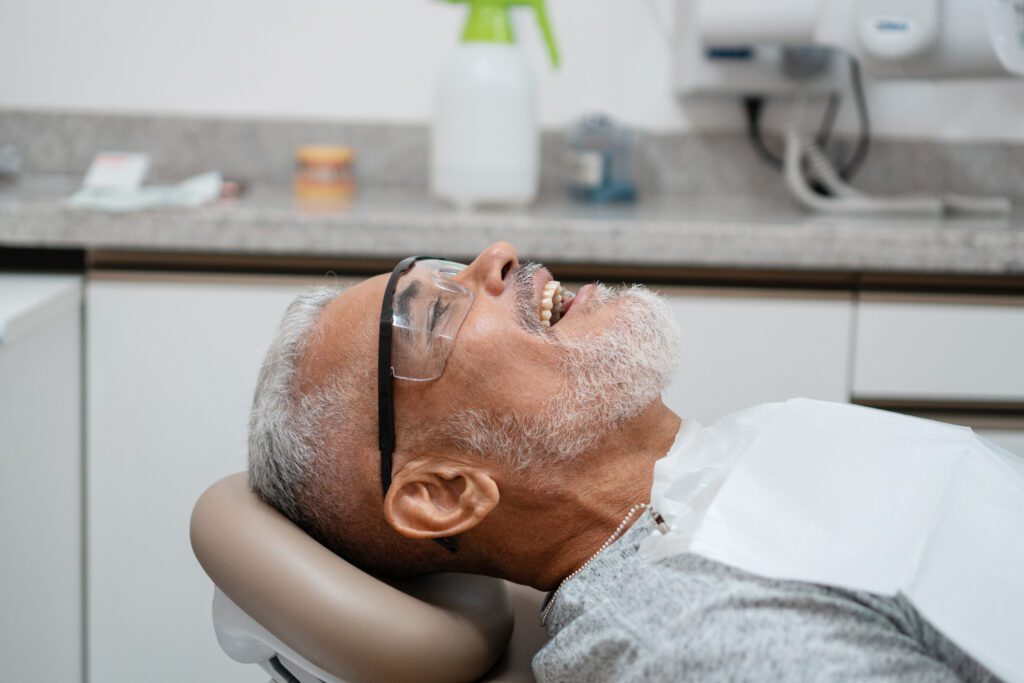Do your gums bleed when you brush and floss? Are your gums sensitive to hot or cold foods and drinks? You may have early signs of periodontitis, also known as gum disease. Gum disease occurs when harmful bacteria build up in the mouth, creating a sticky film called plaque. As plaque hardens, it becomes tartar or calculus. This bacterial build-up irritates the gum tissue and can lead to gum recession and tooth loss over time.
Dr. Walter Mazzella treats gum disease in Woodstock, MD, and helps remove harmful bacteria to reverse symptoms of gum disease. Periodontal therapy and dental lasers offer general dental treatment to prevent future gum health problems. In addition, Dr. Mazzella offers restorative dentistry services to patients in Woodstock, MD, and the surrounding areas.

Common Symptoms of Gum Disease
Early on, patients with gum inflammation can also experience:
- Tender gums
- Gum sensitivity
- Bleeding gums
- Red and purple-colored gum tissue
Patients with gum disease often experience these symptoms:
- Swollen or puffy gums
- Receding gum tissue
- Pus between the gums
- Bad breath (halitosis)
Contact our office if you have any of these symptoms, and we will help you find the right treatment. Sometimes, patients can prevent gingivitis from turning into periodontitis by flossing, brushing, and visiting the dentist regularly. Other patients may require deep cleaning treatments or laser dentistry to remove the infection.
Gum Disease Treatment in Woodstock, MD
Gingivitis, or gum inflammation, is the earliest stage of gum disease. Patients with gingivitis can reverse their symptoms with good oral hygiene and preventative care. As gingivitis progresses into gum disease, patients will need more professional care. Our dental office provides comprehensive gum treatments for patients with gingivitis and periodontitis:
Deep Cleanings
Scaling and root planing treatment are used in tandem to remove plaque and tartar from the gums and tooth roots. During scaling treatment, our hygienists remove bacterial buildup from the gums. They even go beneath the tissue to clean the gums. Root planing cleans plaque and tartar from the tooth roots, which helps keep teeth strong and prevent tooth loss.
Laser Dentistry
We can use a soft tissue laser to perform gingivectomies. A gingivectomy benefits patients who already have deep gum pockets as a result of gum disease. Comfortable dental lasers can remove infected tissue and treat gum pockets to renew the look and health of the gums.
Gum Disease Treatment FAQs
Many people have gum disease without even realizing it. If left untreated, it can have severe consequences for the health of your entire body. Learn more below.
Is gum disease reversible?
Yes, gingivitis, the earliest stage of gum disease, is reversible with professional care and improved oral hygiene at home. Once it progresses to periodontitis, the damage to bone and tissue cannot be completely reversed. However, treatment can stop further progression and stabilize your oral health. Regular dental visits are key to catching the disease early.
What is scaling and root planing?
Scaling and root planing is a deep-cleaning procedure used to treat gum disease. Scaling removes plaque and tartar from above and below the gumline. Root planing smooths the tooth roots to help the gums reattach and prevent bacteria from returning. This treatment reduces inflammation and promotes healing of the gum tissue.
Can gum disease affect my overall health?
Yes, research has shown that gum disease is linked to several systemic health conditions. These include heart disease, diabetes, stroke, and respiratory infections. The inflammation caused by gum disease can contribute to problems throughout the body. Maintaining healthy gums is an important part of protecting your overall health.
How can I prevent gum disease?
Good oral hygiene is the best defense against gum disease. Brush twice a day, floss daily, and use an antibacterial mouthwash to reduce plaque buildup. Regular professional cleanings and checkups help catch early signs of gum problems. Avoiding tobacco products and maintaining a healthy diet also play a major role in prevention.
How often should I see the dentist if I have gum disease?
Patients with gum disease often need more frequent visits than those with healthy gums. Your dentist may recommend checkups and cleanings every three to four months instead of the standard six months. These visits help monitor the disease and prevent it from progressing. Sticking to this schedule significantly improves your chances of maintaining healthy gums.
Is gum disease painful?
In its early stages, gum disease may not cause pain, which is why many people don’t realize they have it. As it advances, you may experience sore gums, discomfort while chewing, or sensitivity. In severe cases, abscesses or infections can cause significant pain. Regular dental visits help detect and treat the disease before it becomes painful.
Improve Your Gum Health
Are you noticing new gum problems? Call Dr. Mazzella today at (410) 559-9951 or schedule your next dental visit online. Let us know if you have any current gum health concerns or questions about treatment. We’re here to help you.
